#that his memory has suffered from erosion directly
Explore tagged Tumblr posts
Text
◟༺✧༻◞ Teyvat chapter storyline preview: Travail —Chinese translation script—
The war has already begun— a continuation of the previous war. The gods encase the outlines of "desire" in seven types of brilliant light. With this, they demonstrate that their authority can be exceeded. Yet smoldering remains lie buried underneath the foundations of reality as a warning to those who overstep their bounds:
"That divine throne in the high heavens was never a seat reserved for you from the start."
But oh, you who oversteps your bounds, do not stop walking here. For none can watch the fire burn from the other side of the river. Watch...
—Act. Prologue: Mondstadt. Mea libertas meus canor (My freedom is my song)—
For the giant dragon who guarded the city of freedom for thousands of years. Doubts about [the concept of] "freedom" have begun to surface. A "freedom" that was ordered by a god— can it still be called freedom?
—Act. I: Liyue. Ruat caelum fiat pactum (Let the contract be made, though the heavens fall)—
In an audience of many, the God of Contracts was assassinated. At the very end, he shall sign a contract to end all contracts.
—Act. II: Inazuma. Perpetua perennis impervia (Perpetual, perennial, impervious)—
Under the immortal Shogun, the era of the Sakoku Decree ordered by the Shogunate sees no end. The god who pursues "Eternity"— What kind of eternity does she find within the eyes of ordinary mortals?
—Act. III: Sumeru. Sub floreis lumen sagacitatis (Under the flowery light of sagacity)—
Wisdom is the enemy of the God of Wisdom. Knowledge is a bait floating on the surface of the sea of ignorance. In the city of learning, the scholars are pushing for foolishness, and the god's wisdom has raised no objections to this.
—Act. IV: Fontaine. Iustitia omnia vincit (Justice defeats all)—
The God of Justice is an ardent admirer of all the farces that take place in the courtroom, even yearning to judge her fellow gods. But one thing is very clear to her: the Heavenly Principles are the one thing she cannot make her enemy.
—Act. V: Natlan. Surge vir fortis I natam victoriam (Rise, O strong man, and go to your destined victory)—
The rules of war are carved into the bodies of all living things: The defeated become embers of the fires of war, while the victors will reignite. The God of War confides this secret with the Traveler, because she has reasons for doing so.
—Act. VI: Snezhnaya. Ducam regina mea gloria haud pluribus impar (Let me lead my queen to near unmatched glory)—
She is a god whom no one will love ever again; She is a god who will never love anyone again. The reason why people follow her Is because they believe one day she will finally be able to raise a flag of rebellion against the Heavenly Principles.
In an eternity with neither beginning nor end, humans shall live a peaceful life without dreams. But in the blind spot of the gods' gaze, there are still people who want to dream.
—Act. ▇▇: Khaenri'ah. The dream yet to be dreamed—
All humans have that innate quality which makes them human; We are not the residue left behind from filtering out those who were "chosen by the gods." From beyond this world, we will obtain the power to reject this world.
Now, you who have traversed heaven and earth— Your travels and journey have ended, But you have yet to cross the final doorway. If you have understood the purpose of your travels, then come forward. Defeat me, command me to step aside, and prove to me that you are more suitable than me to rescue her. After that, go forth spin all the threads of fate anew.
My memory has already suffered too much erosion, but I will always remember, that she also loves these flowers.
#◟༺✧༻◞ fragments of light from the roots of truth ┊reference.┊#I've just come across this#and honestly I find it so interesting#one of the greatest mysteries to me#was the translated 'prove to me that you're worthier than I#to rescue her'#this makes it much better in my eyes#less shippy too for that matter#because it felt like some fight#over to see who deserves more to rescue Lumine or something#also the fact that it's outright said in the ending#that his memory has suffered from erosion directly#that surprised me#but it's a really good touch nonetheless#anyway I have more to say but#I'll stop the ramblings on tags now jfhjg
4 notes
·
View notes
Note
babe I need your lucifer morningstar / wriothesley / zhongli / yoUR FAVS HEADCANONS ASAP <333
ONLY IF YOU WANT TO THOUGH!! I love reading your posts! ♥️♥️
COMING INTO MY ASKS LIKE THIS AND TELLING ME TO WRITE IS GOING TO MAKE ME BECOME A FULL TIME WRITER AGAIN. (i’m not complaining, i have so many thoughts i need to get them out)
zhongli
every one tries to uwu-ify zhongli, and i hate it. this man is an archon, one of the oldest. someone who was a warrior. yes, he’s an extinguished gentleman. curtuous, even. i, however, don’t for one second think he’s always like this.
- firm believer that zhongli has to hold himself back, and is quick to anger and frustration, pre current day liyue at least.
- if anyone questioned him, his commands, his leadership, he’d give them a simple look. jaw sat tight, with an expression so unreadable that it would send a chill down their spine, and that alone was enough to silence them.
- in his story quest (i don’t remember if it was his story quest, or an archon quest it was so long ago), he gets aggressive with the fatui when he started to argue. multiple times, he had that look, and stated that “you will suffer the wrath of the rock… you may find it rather unpleasant.” zhongli does not fuck around.
- an aggressive hater of celestia, and the heavenly principals. there were several times post archon war, that he thought about simply handling the issue at hand himself. believed he could, but would be talked down by the other archons, and adepti.
- then the time came where his hand was forced into a contract with the principals. since then, his anger has subsided at least on the external front. every day, he tries to find a way out of that contract without breaking his own morals, and his own meaning as the god of contacts himself.
- now listen. zhongli stepped down from being an archon, but that does not mean he is no longer a god. the gnosis does not equal godhood. while i believe that he did step down because liyue was entering a godless era, i believe he did it for his own selfish reasons as well. zhongli is known for his intelligence, and he knows that war is coming. in one of ei’s voice lines, she states that she believes his story is far from over. i believe that to be true, he has his own plots, and i think he intends to assist the tsaritsa in taking down the heavenly principals. whether it be directly, or indirectly. he’s up to something. he knows far more than he states. his power has not dwindled one bit.
- zhongli hates the idea of erosion, despite talking about it so casually. i think that it terrifies him. that the thought that one day, all of his memories could fade, and that he’d no longer remember. because of that. due to this, the adepti have began to keep journals, or other forms of keeping track of his retellings. each of them have their own version, so that if one day, rex lapis does not remember his own stories, they will be able to remind him bit by bit.
wriothesley
- oh this man has got a past. the orphanage was not pleasant to him. not in the slightest. wrio blames himself for not noticing sooner. not seeing that some children left, and didn’t return. once he began piecing things together, he knew what he was going to do. he couldn’t allow these things to happen, even though he himself was also a child.
- when it came time for him to kill the parents of the orphanage, he didn’t even hesitate. it happened so quickly. it was brutal, messy. a child can’t carry out something clean, and effortlessly. after releasing the other children, he turned himself in.
- wriothesley has ptsd from this, and reoccurring nightmares. not from the murder, but from the children he couldn’t protect sooner. due to that, his sleeping patterns are not good, and borderline unhealthy. instead, he busies himself with work, and fights in the pankration ring.
- now, when wrio got sentenced to the fortress, it was unpleasant for a child. at first. i think rather quickly, he gained the trust of other inmates. inner circles. it taught him quickly about survival. about calculation, gave him cunning traits, and taught him how to deal his cards just right.
- once his sentence was done, he stayed and became the warden. he wanted to change the fortress. i like to think that the warden before him wasn’t a good person, and that the conditions of the underwater prison weren’t great. once he took over, he changed it all. he likes to view it as more of a rehabilitation center, than a prison.
- the scars on wrios neck are definitely from the orphanage, and i refuse to believe otherwise. perhaps something that happened when he first found out what was happening. he confronted the parents, and ended up with those scars from something terrible. it damaged his vocal cords quite a bit (going off that one hc i saw on tiktok awhile ago that i don’t remember where it came from). the scars cause him quite the bit of discomfort sometimes, it’s a mild irritation. that’s why sigewinne tries to give him those gross health shakes to drink. its a remedy for the soreness.
- during his story quest, the traveler asked if he uses the iron fists in his fight in the pankration ring. he said not always, but sometimes you’ve gotta do what you gotta do right? that man is NOT above playing dirty. he’s an undefeated champion in that ring, and when anyone hears they’re facing him, they’re terrified.
- ^ HOWEVER. he’s decent enough to take those he defeats to the head nurse, get them treatment, and ensure they’re doing fine afterwards. in his trailer, we see him giving them handshakes, nods of acknowledgment. he doesn’t fight to be an asshole, it’s to keep the respect, and well- also a distraction for himself.
- now, if i see one more person say that wriothesley is the type to listen to hardcore rock music, i’ll scream. when we are in his office, he put on music that was similar to that of jazz. wrio is a jazz man, classics, instrumentals. it’s calming to him. firm believer that this man would listen to something like sway by michael bublé religiously.
- even though i believe that wriothesley has it in him to be a gentle man, a gentle lover, i can still acknowledge other aspects about him. he’s a flirt. have you seen how confident that man is? he’s shameless. he knows he’s attractive, and he knows how to sway someone so effortlessly. sinful french falls from his lips like it’s second nature, with such a gentle touch that it could have anyone in the palm of his hand and he knows it.
- he’s so busy with the work of the fortress though, that he doesn’t believe he has time for anything that’s actual romance. i’m not saying that he sleeps around (don’t give this man the gojo treatment guys), he simply flirts and sometimes he doesn’t even know he’s doing it. due to his schedule of business in the fortress, if he did end up developing feelings for someone, i believe it would be someone who either frequents the fortress for work, works there directly, or someone who just as much as of a work ethic as him. he needs someone who understands how hectic it is, so that he doesn’t feel neglectful for not being able to supply his full attention to a partner.
- okay my last one for wrio may be a stretch. i’m not 100% sure of the past of the fortress of meropede, so i can’t say if its symbol has always been the three headed dog of cerberus. however, i like to hc that it only became that after wriothesley became the duke. the symbol of cerberus means the past, the present, and the future. wrios past in the orphanage/the way the fortress operated before him, the present day of his control of things, and the future that he sees for the prison and its inmates. cerberus is the gate keeper, a symbol of loyalty, devotion, tenacity, and protection despite being perceived as a terrifying figure to others. i believe that’s how wrio see’s himself.
lucifer
ANOTHER MAN PEOPLE TRY TO UWU-IFY. STOP IT! HES THE LITERAL FUCKING DEVIL YOU MFS.
- lucifer is the original sin. pride. you cannot be the king of hell, and not have your mind plagued in darkness, full of sin, and questionable morals surrounding your duties.
- in the pilot episode, everyone believed that he wasn’t a good person, that he abandoned charlie, that he was rough, that he didn’t care about the sinners, and only wanted control.
let me tell you why, to an extent, that’s still true.
- lucifer tried to convince charlie that the sinners were awful, terrible people. he did not want her involved, and tried to deter her away from the path of redemption for hells inhabitants. he firmly believed that. i think he still believes that, but, he was slightly swayed by charlie’s words and beliefs. after lilith left him, he became secluded. lucifer wasn’t present as a father. right now, he’s trying to reconcile that, and support her despite not believing in her views himself.
- now, i think that part of the reason why lilith left him was due to his views. with how charlie talks about her, she had similar views as her once upon a time. lilith didn’t like that lucifer viewed the sinners as disposable. it angered her, so she left and that hurt him beyond compare.
- how could anyone expect lucifer to have full faith in redemption for the sinners, believe they were worthy of anything? lucifer is the original sin, they exist because of him. how could he face them, have any love in them, when it only reminded him of his failures as an angel, it reminded him of his pain, his tarnishment of his once devine place? he is pride, of course he can’t face them.
- i also read somewhere once in biblical lore, that without sinners, the seven deadly sins powers would dwindle. if people did not have pride, if they weren’t ridden in that sin, lucifer could lose a portion of his power overtime, be weakened. i personally like this, because that’s a solid reason why he wouldn’t want anyone to be redeemed.
- lucifer was abandoned, tossed aside by his father, by his brothers, for what? having a different opinion, wanting to offer different views. in result, it created darkness, pain, it created hell. lucifer is the cause of it. he carries heavy burdens, guilt, eons of trauma. for a millennia, the only thing he has seen is the pain, and the darkness of others in people he tried to defend.
- i need to see his rage, i need to his anger, his darkness, and inside his mind. i know it’s there, and its aching to be released. give me the fight between him and heaven. lucifer is one of the strongest beings in creation, show me his power.
not related to any of that, however!!
there’s a song called whisper by burn the ballroom that i believe fully captures the idea of falling in love with lucifer.
- “so give me your fire, give me your fear, give me your faith when love gives you tears. give me your heart, give me your fate, give me your hand when love gives you hate. give me your prayers up on your feet, and i’ll give you a show it helps fill the seats. so give me your sins, give me your lies, but whisper your love and i’ll whisper mine.” lucifer is so debated after lilith, that falling in love with someone who accepted his sins, his darkness, his rage- it was so foreign. it terrified him of that loss again. he needs someone who understands that depth, his reasoning, his hesitations, his views.
- additionally, the song had a line that says: “and he cries out to god, how could you claim them all when i know that they’re all mine?” this goes hand and hand with my view of lucifer not wanting to redeem sinners for the sake of his power. additionally, imagine how hurt and pissed off he would be when the first sinners get redeemed. how could god, how could heaven accept those redeemed back into the heavenly gates so willingly, but have turned their backs on him with a second of hesitation or his own chance of redemption?
GOD I LOVE LUCIFER MORNINGSTAR
i am so in love with all of these characters, they are so complex, with so much depth and characteristics to analyze. i’m snorting it all like crack 24/7 <3
#also hey!! drop your genshin uid to me!#send help i need to reorganize my blog and fix my links still#i don’t remember where anything is#i decided to make this somewhat an actual post#i did not proof read any of this i was so excited to ramble LMAO#genshin impact#hazbin hotel#lucifer morningstar#lucifer morningstar x reader#lucifer morningstar hcs#wriothesley#wriothesley x reader#wriothesley hcs#zhongli x reader#zhongli hcs#wriothesley headcanons#lucifer#lucifer headcanons#lucifer hazbin#zhongli headcanons
75 notes
·
View notes
Text
I was going to complain about something else, but since I dug up this dialogue, I’ll directly complain about Azhdaha.
Azhdaha’s situation is kinda weird on the whole because of the erosion point. Here is what Kun Jun (possessed by Azhdaha’s “good side”) says about it:
Kun Jun: The memories of rocks do not last long. Those memories that survive are rooted in powerful emotion. But as time passes, so these memories fade into obscurity. Erosion is the world's greatest destroyer of memories. Kun Jun: Erosion ground Azhdaha's consciousness into oblivion. Slowly, he forgot the face of his old friend, and his memories of defending Liyue Harbor disintegrated. Kun Jun: Azhdaha, now incomplete, became irascible... aggressive. Jiu: What would you expect!? It was humanity that attacked the Ley Lines that sustained me! Kun Jun: This much is true. Which is why "you" attacked The Chasm... why "you" waged war against Morax. Kun Jun: In the beginning, in order to open up new territory and increase production, the citizens of Liyue came to the mountains to mine. Overexploitation caused the Ley Lines to quake, which brought untold suffering to "us." Kun Jun: Erosion made "us" even more savage. No matter how we struggled, we lost the ability to coexist with humanity... we lost all reason. Kun Jun: Morax shared with us some of his power, to prevent further erosion. But... it was futile. Everything returns to dust. It is the natural order, an unstoppable force.
Erosion made Azhdaha forget his friendship with Zhongli and his previous dedication to Liyue, while also making him more savage and uncontrollable.
So, when humans damaged the Ley Lines and caused him great pain, he directly attacked the Chasm and fought Morax when he tried to stop him. As a result, Morax could do nothing except seal him away, which Azhdaha agreed to with his... well, with what “Kun Jun” personifies.
Kun Jun: And so, "we" became "you." And from your will... "I" emerged. Kun Jun: I am your final contract. Witness the promise between Azhdaha and Morax. You can hate me... but you cannot deny me. Kun Jun: I am the remnants of Azhdaha's benevolence, the echo of a contract set in stone. I harbor a willingness to go further, a willingness to coexist peacefully with mankind. Jiu: No, no! It is I, Azhdaha, forged of elemental crystal, bearer of the weight and memories of the earth, older than the mountains and the oceans that decides! I will not swear allegiance to this insect! Kun Jun: Morax is not an insect. Jiu: A lord over insects is nothing but an insect in turn! Kun Jun: You forgot yourself. Nobody held Morax in higher regard than you or I. Kun Jun: That which you have forgotten, I hold here in my heart. If you are the memory of the earth... then I am the memory of coexistence... of coexistence with humanity.
This is all... I’m not sure how to explain, but it’s all kind of wild to me.
Humans harmed the Ley Lines and thus harmed Azhdaha. But you see, Azhdaha was wrong because he was actually crazy and had lost his memories. And that’s why Morax “chose justice, but did not forsake kindness” by sealing him away to suffer “a thousand years of pain” while also admitting that he didn’t actually have much of an option because Azhdaha was so powerful Morax was barely able to match him anyway.
And in the meantime, humans have continued to screw around in the Chasm, leading up to it having to be sealed off yet again, as well as what seems to be at least one other instance of mining until they harm Ley Lines in Mt Tianheng.
Imagine if, in FF7, everyone just went “well, yes, Shinra is draining the Lifestream, but it’s the Planet that is in the wrong for attacking them, so it’s totally correct to seal it away and keep draining the Lifestream anyway.”
?????
Zhongli is praised for not approaching Azhdaha “as an assassin” but in what way could he have done that when Azhdaha is an absolutely massive beast that was rampaging across the entire Nantianmen area? How do you assassinate a dragon the size of a mountain? Do they mean that he never intended to take Azhdaha’s life? But then Zhongli says he didn’t have the power to do that anyway, so...
Azhdaha lost his memories of their friendship and his time with humans, but he definitely remembers all this a thousand years down the line anyway. This erosion business sure is selectively and conveniently applied... That aside, this is all ascribed to stones having short memories, so did he stop living with humans for this to have become a distant memory to him? If so, why?
Keep in mind, this isn’t because Azhdaha is approaching the end of his life. Kunjun even says, “My life is nigh on eternal. I will go on with the infinite flow of time.” He’s going to exist sealed away in apparent agony (???) for eternity now. Cool! Definitely a solution!
There is no mention at all of anything Morax might have done to deal with the Ley Line damage, even though Zhongli talks for quite a bit after Azhdaha’s departure and could have brought it up. And yes, it happens again afterwards.
And of course, not a single actual human features in this entire business. I love having non-human characters fight each other about how to coexist with eternally off screen humans.
There’s other issues too, like the extremely, weirdly ambiguous nature of Azhdaha’s “coexistence” with humans. Like, did he take a human form? How did he “live beside them” as the developer video puts it? And at the same time, it is indeed the case that there is no mention of his existence anywhere in the harbor or outside ancient stone tablets or artifacts. This is a little weird because even Guizhong, who died like four times as long ago has more mention at the Guili Plains and with the Ballista.
None of the immortal characters brought him up ahead of time either. Was this kind of situation where an ally goes insane and has to be sealed away so common that it doesn’t stand out to them anymore?
I don’t know, it’s just all so......... weirdly handled.
6 notes
·
View notes
Text
Trans Catalina Trail
by Andrea Ehrgott – Aug 2021
I am convinced that every additional ounce in one’s backpack results in bruises, blisters, aches and pains on a logarithmic scale. In preparation for our Trans Catalina Trail (tct) trip—a last minute change due to smoke in the Sierras, I even weighed my underwear to select the lightest. As for a tent, it had to be feather weight, so I ordered a bivvy, a flimsy nylon sarcophagus providing a mere two inches of room to the sides and four inches above my sleeping bagged body, but weighing only 1.5 lbs. Sadly REI has not yet figured out how to make water lighter.
Shortly after the ferry left San Pedro harbor, where we’d been mesmerized watching containers being unloaded and loaded on cargo ships like an automated unstoppable lego building exercise, the intimidating profile of Catalina came clearly into view. I wondered if there was any chance a quick gust of accelerated erosion might lower the steep mountains a few hundred feet before we docked.
We three are in our sixties, arguably too old for an adventure involving backpacks, five nights camping, and hiking over thirty miles from one end of the island to the other. We’ve known each other since our kids were in preschool and we’ve hiked in our local SM mountains over the years, but this was the first time we’d carried backpacks and camped together, the first time we’d shared dehydrated dinners, band-aids, toilet paper, and sporks. To add to the absurdity, we thought it would be a lark to wear pearl (fake) necklaces. Why not?
We walked along the coast from Two Harbors the first overcast morning and after several miles found a deserted private club where three Adirondack chairs invited us to stop and take our boots off and gaze at the yacht-dotted sea. A swim in the clear water of Emerald Bay refreshed us sufficiently for the long walk back to the campground and along the way, a bald eagle soared over the inlets. It was a sweet warm-up to our trek. That night, after Fish and Chips at the only restaurant, I wormed into my sleeping bag and bivvy. Through the fly net, I studied the starry night sky and fell asleep to the monotonous rhythm of breaking waves.
The trail, the next day, took us inland up a mountain (1500’) and down again to Little Harbor on the other side of the island. It was tough and slow-going. We arrived early enough to relish the pretty coves, the campground shaded by Canary Palms, to swim along the rocky point, to paint, and wash clothes, all while keeping a close eye on a lone bison, apparently a permanent camp resident. He seemed most at home in our campsite and slept soundly under a tree not far from us that night.
From Little Harbor to the next campground, Black Jack, was hard work. The trail climbed steadily up to the middle of the island, and from the moment the sun rose, it was hot. Among the chaparral’s dry grass, browned shrubs and prickly pear, the few trees seemed defeated by the drought, leaves shriveled, few in number, and coated in dust. We stopped regularly to drink water, adjust our backpacks, soak up the panoramic views and to watch a herd of bison grazing. The promise of lunch at the small airport cafeteria motivated us to keep going. Suffering a little from heat exhaustion plus a good amount of regular exhaustion, we stayed at the airport long after our lunch, waiting for the air conditioner to revive us and for the heat of the day to pass before we continued. The last two miles to Black Jack, although tiring, was quite lovely with more diversity in the vegetation and more interesting topography. At this campground, the only one accessible exclusively to backpackers, we got a true sense of how many people hike the TCT. Not many. I could count the tents on one hand. I don’t know my astronomy but the night sky was beautiful and three planets stood out among the stars, dimmed only when the moon rose. Getting in and out of the bivvy is difficult at the best of times, but when leg cramp woke me up later that night, it was a slow, painful, and complicated effort to extract myself from the double confines of sleeping bag and tiny tent. A little later, after I’d wriggled my way back in, several bison walked through the moonlit campground, and I heard one snorting and huffing nearby. The only reason I slept is because I imagined they had to be ground squirrels or foxes, looking for scraps.
We left early the next day for the longest leg of the trail, 11 miles, to Hermit Gulch campground a mile outside Avalon, the main town on the island and our terminus. It was long and hot, long and hard, long and dusty, long and steep. At times the trail ran alongside a dirt road with traffic, at times it deviated, and other times it overlapped with the road, not the wilderness experience we longed for. There were trucks carrying cement, trucks servicing the cell phone towers and other infrastructure, and there were “safari” jeeps carrying tourists across the island, presumably to see the bison and beaches. Evidently we were unusual specimens to be pointed out too. One jeep stopped on the roadside and we heard the driver who was pointing at us, talking over the microphone to his safari customers mentioning words like “backpack” and “camp” and “35 miles”. I decided, like any wild animal under observation, to speed up and make myself scarce.
It was a relief to finally reach Hermit Gulch campground, to rest, eat and shower. Foxes and deer visited as the sun went down. However a few hours later when we were ready to sleep (at eight pm), other campers were warming up with vodka and drugs for loud partying which went on long after midnight. I’d like nothing more than to erase this night from the adventure so that it doesn’t leave a sour taste. Next time I’d avoid this stop; I’d continue all the way to Avalon directly and take the evening ferry home, dirt and all.
Will I do this again, I kept asking myself? Apart from a level of fitness and a tolerance for dirt and discomfort, backpacking requires organized discipline and a good memory for all the storage details. A bottle of water must be within easy reach at all times, sunblock has to be reapplied throughout the day, blisters attended to, a tent rolled up wet from morning dew has to be dried out later in the day. I’m not so worried that my legs will be the reason I stop backpacking, or my back; it’s more likely to be my memory. What happened to my chap-stick? Who has the map? Which pouch did I put the granola bar in? Where did I put the car keys? Sad to say, I lost the pearls. They were probably left at one of the campgrounds and whoever camps there next must be mystified. I also lost the matches, necessary to start the stove - fortunately my fellow camper had a lighter. And a toenail is still tender and dark red suggesting that I will be losing that too before long.
But yes, it was worth it. There is satisfaction in taking any inviting path from beginning to end, and a feeling of accomplishment in following a ridge to stand atop a mountain from where horizons are widest. There is the delight of swimming in and out of clumps of healthy kelp after being overheated and dusty. It’s lovely to get to know friends even better, and it’s pure euphoria when it’s all over and the boots come off.
0 notes
Note
If it showed up in a comic and I missed all of it, I am so disappointed in myself right now. Please let me know if you ever find out where that happened. Regardless, I’m in love with your idea.
The image of a woman standing over his grave in the darkest hour of night, the only consistency in every panel being skin so dark that she is difficult to see at certain angles. Though once you see her, she looks starkly unfamiliar to the world around her. Even the air is rigid and afraid. Yet, every movement feels like it never happened, that she was always in that position; the way that erosion along a riverside is never noticed by those that walked by it every morning for years.
Suddenly, she’s on her knees on the ground above a grave. She must be directly above the coffin of whomever lies eternally underneath. Two hands drop down to the soil in front of her, clutching at the dirt desperately, her face finally visible, as if existing for the first time. It’s unearthly, unnatural, yet nothing has ever felt more true than the pain etched on it. It’s a mystery whether it is shadows in the dark night across her dark skin atop the dark ground, or whether soil truly is climbing up her hands. It stills, after a moment, and something pure white falls from her face. A mimicry of a tear, maybe. Making her seem capable of hurting the way humans do, to lull them into sympathy.
There are words spoken in a voice that must be older and heavier than any wind. The language is no language, it would be a maddening task to attempt make any sense out of it. But somehow, all her creatures know she says, “I am not through with your suffering yet.”
A whisper of wind, a blink of an eye, and she is gone, as if never having appeared. Because she never leaves. Old souls lingering in the graveyards take their moment to mourn for the risen. Then, the faintest sound of a scream can be heard: “Bruce!”
“He’s rarely boring” LMAO one way of putting it. Just the idea of Gotham deciding Jason has suffered and understood her, that he’s willing to do anything for her (not that Gotham has an opinion on what should or shouldn’t be done, just that Jason’s will towards it is strong. Even as Robin).
Makes sense that Gotham would take Jason’s murder at the hands of the Joker as being a murder committed by Sheila (his mother, so, also unnatural), and then by Bruce’s hand, and fixing those specifically. For whatever reason. So Jason is unkillable to the extent that it can’t be his family that kill him.
I enjoy it when Jason’s head is working against him. It balances out his genius :] also, I just enjoy it. But really, one eldritch entity is already beyond human comprehension, and could make someone go mad. Two? With two distinct forces? Insanity.
Maybe too comedic to be how it goes down for Steph, but it is hilarious. Though, she could just remember very vague bits. Less like they’re memories, more like they’re common sense and she can see them in the world around her. Random bursts of “insanity” because she saw a bird fly by a window, and her mind just put together the link between a hazy memory from Gotham. Theoretically, she would know what she just understood and what the pieces of the puzzle she put together mean, but she can’t comprehend it. But it still makes her head spin, and she knows it far more than any person should know. The typical mind fucky eldritch stuff.
OK, so I know Jason came back cos of the whole Superboy punched reality thing, but I can't deny I tend to gloss over that due to me being weird and cos it doesn't fit in every timeline but I digress.
Thus, I like to imagine Jason (& maybe Steph) Are brought back by Gotham itself, cos the place is an Eldrich location and may have worn Steph as a skin suit once.
So for Jason its just like, "You are my favorite son who died so far from mother, but you're not done yet, so wake up."
Cue Jason waking up underground.
Steph could be a similarly intended resurrection or Gotham just wearing her body, cos Steph was another favored child so her body was a neat fit post death. Then when Gotham leaves it, Steph's spirit just bounces back in like "Holy shit, what the fuck?"
That’s so wild. I love it. I’m able to put aside the timelines not matching up with the Superboy-Prime thing because nothing in DC lines up lol, but I’m so willing to build on this idea instead. The concept that Gotham itself corrected what it considered a mistake, and that it had to wait until Jason was buried in its own soil to act, makes his resurrection feel so much more personal. Far more intentional than just another crack caused by a tantrum. That blends so well with the way Jason speaks of Gotham like it’s alive. Maybe he doesn’t truly know it, but he understands on a subconscious level that there’s some level of consciousness to this insane city. It just gives me more reasoning ti say that Jason has more of a claim to Gotham than Bruce ever could. + It’s a neat explanation for Jason’s second revival: Jason can’t die like this, murdered by his own father, it’s unnatural. Plain & simple.
That sounds like such a disturbingly weird experience. Would Steph remember that? Would the others have seen her, alive but so…unearthly.
Kinda unrelated, but I like to think of the Lazarus as an eldritch entity, so how those two would mix with Jason is interesting to think about. They could clash as Jason’s roots VS the foreign entity that healed him.
#the way that you described the scene with gotham as it would actually look in a comic but i gave but after not even a whole sentence and#just started writing. visual arts are not my passion lol#its 3am and my blog im allowed to ramble. as a treat
343 notes
·
View notes
Text
A formerly suicidal Salt Lake City firefighter got help — and now he’s urging other first responders to consider therapy
After a sleepless two days at the firehouse, Capt. Mike Stevens trudged up the stairs to his bedroom and pulled out his .40-caliber handgun. He sat on the edge of his bed and began to make a mental list of the reasons he should end his own life and the reasons he shouldn’t.
He thought his wife would be able to find a better husband and, if he died, she could take the life insurance and pay off the house. He felt he was no longer making a difference. He sat there holding the gun for about 15 minutes, ticking through reasons to shoot himself.
But then, like a lightning bolt, one thought knocked aside his grim list — “There are people on this planet that I haven’t pissed off yet.”
He’d struggled with depression and nightmares for years, but therapy eventually helped him work through trauma accumulated over his lengthy career as an emergency medical technician and then a firefighter in Salt Lake City. Today, he urges other firefighters to protect their mental health.
“I kept my demons hidden for many years,” Stevens said. “I didn’t want to infect anyone else, that was my train of thought. There’s some logic to that, but it finds its way out one way or another.”
Stevens will join a panel of first responders on Thursday, May 24, at 7 p.m. at the Salt Lake City Main Library to talk about the toll their jobs can take on their mental health. The free event is being presented by The Salt Lake Tribune, which recently published “Officer in Distress,” a series that focused on West Jordan Detective Brent Jex and his guilt over the death of a friend in uniform.
Jex can’t appear at the Trib Talk Live event due to professional responsibilities. Instead, Tribune Editor Jennifer Napier-Pearce will interview Stevens, a 29-year veteran of the city Fire Department, along with Sgt. Lisa Pascadlo, a peer support coordinator for the Salt Lake City Police Department; state Rep. Lee Perry, a lieutenant with the Utah Highway Patrol; and Shante Johnson, a spokeswoman with the Utah Fraternal Order of Police and the widow of Draper Sgt. Derek Johnson, who was killed in the line of duty in 2013.
The stories of Jex and Stevens are similar. They are big, imposing men who grew up with an instinct to help others. They came to their respective professions early and with great enthusiasm. And over time, what they saw on the job, particularly the deaths of young children, weighed them down.
Around the year 2000, Stevens was a member of an emergency crew sent to a downtown apartment building where a boy, about 1 year old, had stopped breathing. They gave him CPR and rushed him to Primary Children’s Hospital where Stevens sat with his devastated parents. The boy died.
About a decade later, Stevens responded to a call after a father had taken cold medication, fallen deeply asleep and rolled onto his 18-month-old son. Stevens said he felt a “sinking feeling” as he handed the boy off to medics. That boy died, too.
Stevens remembers a young man dragged behind a TRAX train when it snagged the bag he was carrying over his shoulder. Stevens and his fellow firefighters picked up the man’s remains and put them in small plastic bags.
He says, generally, he can handle the blood, the car wrecks and near drownings. “But being able to say it doesn’t affect you isn’t exactly true.”
No major event led to the suicidal thoughts that spurred Stevens to pull out his .40-caliber in 2011. It was an erosion of his self-esteem and a lack of sleep, he said, driven by reliving past calls that he tends to describe as “not so good.”
In the months afterward, he tried to cope with times of stress by going the gym and chopping firewood. But then, about two years later, the nightmares came back, becoming more frequent, more alarming, until he was wracked by horrors every time he drifted off. He’d dream of the dad who rolled over on his son, and then his mind would morph that tragedy into something worse — the father died too, or maybe everyone in the house.
He ended up seeing a therapist who specializes in EMDR, which stands for eye movement desensitization and reprocessing. The therapy is used frequently for those who suffer from post-traumatic stress or similar mental health problems, including members of the military, rape survivors and first responders.
In EMDR, a therapist breaks down traumatic events into the ways a person experienced them, asking a patient to recall visual images and body sensations and hoping to help change how the brain responds to these memories.
It helped Stevens eliminate the nightmares and moderate his mood swings. He still isn’t comfortable around strangers, and has moved into a fifth-wheel camper in a remote part of Utah. He is still trying to rebuild relationships with his family.
He urges his fellow firefighters to take advantage of department resources, including peer support teams and psychiatrists available for phone conversations.
At the urging of Battalion Chief Mike Fox, researchers at the University of Utah launched an experiment called “Mind Shield” in 2017, where all firefighters participated in three one-hour training sessions meant to reduce suicidal thoughts, depression and substance abuse. That study is still underway, said lecturer Rich Landward, with the College of Social Work.
Aaron Burgin created a nonprofit called Suicide Sucks after his brother, Scott, died by suicide in 2009. The idea was to push suicide prevention ads and links higher in search results when a person types suicide-related keywords into Google or any other search engine. Burgin’s group also created YouTube videos. He asked Stevens, his stepfather, to talk directly to other firefighters.
In the video, posted in May 2017, Stevens said: “The stigma of going to seek therapy, it is not there anymore. It is more commonplace now than you think. Set your pride on the shelf and get the help you need.
“You are here for a reason. We all got into Fire and EMS to help others,” he said. “You have a gift most people on this planet don’t. You would lay your life on the line for someone you don’t know because you give a s—. Don’t take that away from someone who still needs you.”
Source Article
The post A formerly suicidal Salt Lake City firefighter got help — and now he’s urging other first responders to consider therapy appeared first on E FANUC.
Read full post at: http://www.e-fanuc.com/a-formerly-suicidal-salt-lake-city-firefighter-got-help-and-now-hes-urging-other-first-responders-to-consider-therapy/
0 notes
Text
Toxic algae flourishes despite vast sums spent to prevent it
New Post has been published on http://usnewsaggregator.com/toxic-algae-flourishes-despite-vast-sums-spent-to-prevent-it/
Toxic algae flourishes despite vast sums spent to prevent it
Competing in a bass fishing tournament two years ago, Todd Steele cast his rod from his 21-foot motorboat — unaware that he was being poisoned.
A thick, green scum coated western Lake Erie. And Steele, a semipro angler, was sickened by it.
Driving home to Port Huron, Michigan, he felt lightheaded, nauseous. By the next morning he was too dizzy to stand, his overheated body covered with painful hives. Hospital tests blamed toxic algae, a rising threat to U.S. waters.
“It attacked my immune system and shut down my body’s ability to sweat,” Steele said. “If I wasn’t a healthy 51-year-old and had some type of medical condition, it could have killed me.”
He recovered, but Lake Erie hasn’t. Nor have other waterways choked with algae that’s sickening people, killing animals and hammering the economy. The scourge is escalating from occasional nuisance to severe, widespread hazard, overwhelming government efforts to curb a leading cause: fertilizer runoff from farms.
Pungent, sometimes toxic blobs are fouling waterways from the Great Lakes to Chesapeake Bay, from the Snake River in Idaho to New York’s Finger Lakes and reservoirs in California’s Central Valley.
Last year, Florida’s governor declared a state of emergency and beaches were closed when algae blooms spread from Lake Okeechobee to nearby estuaries. More than 100 people fell ill after swimming in Utah’s largest freshwater lake. Pets and livestock have died after drinking algae-laced water, including 32 cattle on an Oregon ranch in July. Oxygen-starved “dead zones” caused by algae decay have increased 30-fold since 1960, causing massive fish kills. This summer’s zone in the Gulf of Mexico was the biggest on record.
Tourism and recreation have suffered. An international water skiing festival in Milwaukee was canceled in August; scores of swimming areas were closed nationwide.
Algae are essential to food chains, but these tiny plants and bacteria sometimes multiply out of control. Within the past decade, outbreaks have been reported in every state, a trend likely to accelerate as climate change boosts water temperatures.
“It’s a big, pervasive threat that we as a society are not doing nearly enough to solve,” said Don Scavia, a University of Michigan environmental scientist. “If we increase the amount of toxic algae in our drinking water supply, it’s going to put people’s health at risk. Even if it’s not toxic, people don’t want to go near it. They don’t want to fish in it or swim in it. That means loss of jobs and tax revenue.”
Many monster blooms are triggered by an overload of agricultural fertilizers in warm, calm waters, scientists say. Chemicals and manure intended to nourish crops are washing into lakes, streams and oceans, providing an endless buffet for algae.
Government agencies have spent billions of dollars and produced countless studies on the problem. But an Associated Press investigation found little to show for their efforts:
—Levels of algae-feeding nutrients such as nitrogen and phosphorus are climbing in many lakes and streams.
—A small minority of farms participate in federal programs that promote practices to reduce fertilizer runoff. When more farmers want to sign up, there often isn’t enough money.
—Despite years of research and testing, it’s debatable how well these measures work.
———
DEPENDING ON FARMERS TO VOLUNTEER
The AP’s findings underscore what many experts consider a fatal flaw in government policy: Instead of ordering agriculture to stem the flood of nutrients, regulators seek voluntary cooperation, an approach not afforded other big polluters.
Farmers are asked to take steps such as planting “cover crops” to reduce off-season erosion, or installing more efficient irrigation systems — often with taxpayers helping foot the bill.
The U.S. Natural Resources Conservation Service, part of the Department of Agriculture, says it has spent more than $29 billion on voluntary, incentive-based programs since 2009 to make some 500,000 operations more environmentally friendly.
Jimmy Bramblett, deputy chief for programs, told AP the efforts had produced “tremendous” results but acknowledged only about 6 percent of the nation’s roughly 2 million farms are enrolled at any time.
In response to a Freedom of Information Act request, the agency provided data about its biggest spending initiative, the Environmental Quality Incentives Program, or EQIP, which contracts with farmers to use pollution-prevention measures and pays up to 75 percent of their costs.
An AP analysis shows the agency paid out more than $1.8 billion between 2009 and 2016 to share costs for 45 practices designed to cut nutrient and sediment runoff or otherwise improve water quality.
A total of $2.5 billion was pledged during the period. Of that, $51 million was targeted for Indiana, Michigan and Ohio farmers in the watershed flowing into western Lake Erie, where fisherman Steele was sickened.
Yet some of the lake’s biggest algae blooms showed up during those seven years. The largest on record appeared in 2015, blanketing 300 square miles — the size of New York City. The previous year, an algae toxin described in military texts as being as lethal as a biological weapon forced a two-day tap water shutdown for more than 400,000 customers in Toledo. This summer, another bloom oozed across part of the lake and up a primary tributary, the Maumee River, to the city’s downtown for the first time in memory.
The type of phosphorus fueling the algae outbreak has doubled in western Lake Erie tributaries since EQIP started in the mid-1990s, according to research scientist Laura Johnson of Ohio’s Heidelberg University. Scientists estimate about 85 percent of the Maumee’s phosphorus comes from croplands and livestock operations.
NRCS reports, meanwhile, claim that conservation measures have prevented huge volumes of nutrient and sediment losses from farm fields.
Although the federal government and most states refuse to make such anti-pollution methods mandatory, many experts say limiting runoff is the only way to rein in rampaging algae. A U.S.-Canadian panel seeking a 40 percent cut in Lake Erie phosphorus runoff wants to make controlling nutrients a condition for receiving federally subsidized crop insurance.
“We’ve had decades of approaching this issue largely through a voluntary framework,” said Jon Devine, senior attorney for the Natural Resources Defense Council. “Clearly the existing system isn’t working.”
Farmers, though, say they can accomplish more by experimenting and learning from each other than following government dictates.
“There’s enough rules already,” said John Weiser, a third-generation dairyman with 5,000 cows in Brown County, Wisconsin, where nutrient overload causes algae and dead zones in Lake Michigan’s Green Bay. “Farmers are stewards of the land. We want to fix the problem as much as anybody else does.”
The Environmental Protection Agency says indirect runoff from agriculture and other sources, such as urban lawns, is now the biggest source of U.S. water pollution. But a loophole in the Clean Water Act of 1972 prevents the government from regulating runoff as it does pollution from sewage plants and factories that release waste directly into waterways. They are required to get permits requiring treatment and limiting discharges, and violators can be fined or imprisoned.
Those rules don’t apply to farm fertilizers that wash into streams and lakes when it rains. Congress has shown no inclination to change that.
Without economic consequences for allowing runoff, farmers have an incentive to use all the fertilizer needed to produce the highest yield, said Mark Clark, a University of Florida wetland ecologist. “There’s nothing that says, ‘For every excessive pound I put on, I’ll have to pay a fee.’ There’s no stick.”
Some states have rules, including fertilizer application standards intended to minimize runoff. Minnesota requires 50-foot vegetation buffers around public waterways. Farmers in Maryland must keep livestock from defecating in streams that feed the Chesapeake Bay, where agriculture causes about half the nutrient pollution of the nation’s biggest estuary.
But states mostly avoid challenging the powerful agriculture industry.
Wisconsin issues water quality permits for big livestock farms, where 2,500 cows can generate as much waste as a city of 400,000 residents. But its Department of Natural Resources was sued by a dairy group this summer after strengthening manure regulations.
The state’s former head of runoff management, Gordon Stevenson, is among those who doubt that the voluntary approach will be enough to make headway with the algae problem.
“Those best-management practices are a far cry from the treatment that a pulp and paper mill or a foundry or a cannery or a sewage plant has to do before they let the wastewater go,” he said. “It’s like the Stone Age versus the Space Age.”
———
QUESTIONABLE RESULTS
Do the anti-pollution measures subsidized by the government to the tune of billions of dollars actually work?
Agriculture Department studies of selected watersheds, based largely on farmer surveys and computer models, credit them with dramatic cutbacks in runoff. One found nitrogen flows from croplands in the Mississippi River watershed to the Gulf of Mexico would be 28 percent higher without those steps being taken.
Critics contend such reports are based mostly on speculation, rather than on actually testing the water flowing off fields.
Although there is not a nationwide evaluation, Bramblett said “edge of field” monitoring the government started funding in 2013 points to the success of the incentives program in certain regions.
Federal audits and scientific reports raise other problems: Decisions about which farms get funding are based too little on what’s best for the environment; there aren’t enough inspections to ensure the measures taken are done properly; farm privacy laws make it hard for regulators to verify results.
It’s widely agreed that such pollution controls can make at least some difference. But experts say lots more participation is needed.
“The practices are completely overwhelmed,” said Stephen Carpenter, a University of Wisconsin lake ecologist. “Relying on them to solve the nation’s algae bloom problem is like using Band-Aids on hemorrhages.”
The AP found that the incentives program pledged $394 million between 2009 and 2016 for irrigation systems intended to reduce runoff — more than on any other water protection effort.
In arid western Idaho, where phosphorus runoff is linked to algae blooms and fish kills in the lower Snake River, government funding is helping farmer Mike Goodson install equipment to convert to “drip irrigation” rather than flooding all of his 550 acres with water diverted from rivers and creeks.
But only 795 water protection contracts were signed by Idaho farmers between 2014 and 2016, accounting for just over 1 percent of the roughly 11.7 million farmland acres statewide. Even if many farmers are preventing runoff without government subsidies, as Bramblett contends, the numbers suggest there’s a long way to go.
Goodson says forcing others to follow his example would backfire.
“Farmers have a bad taste for regulatory agencies,” he said, gazing across the flat, wind-swept landscape. “We pride ourselves on living off the land, and we try to preserve and conserve our resources.”
But allowing farmers to decide whether to participate can be costly to others. The city of Boise completed a $20 million project last year that will remove phosphorus flowing off irrigated farmland before it reaches the Snake River.
Brent Peterson spends long days in a mud-spattered pickup truck, promoting runoff prevention in eastern Wisconsin’s Lower Fox River watershed, where dairy cows excrete millions of gallons of manure daily — much of it sprayed onto cornfields as fertilizer.
The river empties into algae-plagued Green Bay, which contains less than 2 percent of Lake Michigan’s water but receives one-third of the entire lake’s nutrient flow. Farmers in the watershed were pledged $10 million from 2009 to 2016 to help address the problem, the AP found.
Peterson, employed by two counties with many hundreds of farms, has lined up six “demonstration farms” to use EQIP-funded runoff prevention, especially cover crops.
“This is a big step for a lot of these guys,” he said. “It’s out of their comfort zone.”
And for all the money devoted to EQIP, only 23 percent of eligible applications for grants were funded in 2015, according to the National Sustainable Agriculture Coalition.
Funding of the incentives program has risen from just over $1 billion in 2009 to $1.45 billion last year. The Trump administration’s 2018 budget proposes a slight cut.
“It sounds like a lot, but the amount of money we’re spending is woefully inadequate,” said Johnson of Heidelberg University.
———
ALGAE PLAGUE SPREADS
While there’s no comprehensive tally of algae outbreaks, many experts agree they’re “quickly becoming a global epidemic,” said Anna Michalak, an ecologist at the Carnegie Institution for Science at Stanford University.
A rising number of water bodies across the U.S. have excessive levels of nutrients and blue-green algae, according to a 2016 report by the Environmental Protection Agency and U.S. Geological Survey. The algae-generated toxin that sickened Steele in Lake Erie was found in one-third of the 1,161 lakes and reservoirs the agencies studied.
California last year reported toxic blooms in more than 40 lakes and waterways, the most in state history. New York created a team of specialists to confront the mounting problem in the Finger Lakes, a tourist magnet cherished for sparkling waters amid lush hillsides dotted with vineyards. Two cities reported algal toxins in their drinking water in 2016, a first in New York.
More than half the lakes were smeared with garish green blooms this summer.
“The headlines were basically saying, ‘Don’t go into the water, don’t touch the water,'” said Andy Zepp, executive director of the Finger Lakes Land Trust, who lives near Cayauga Lake in Ithaca. “I have an 11-year-old daughter, and I’m wondering, do I want to take her out on the lake?”
The U.S. Centers for Disease Control and Prevention is developing a system for compiling data on algae-related illnesses. A 2009-10 study tallied at least 61 victims in three states, a total the authors acknowledged was likely understated.
Anecdotal reports abound — a young boy hospitalized after swimming in a lake near Alexandria, Minnesota; a woman sickened while jet-skiing on Grand Lake St. Marys in western Ohio.
Signs posted at boat launches in the Hells Canyon area along the Idaho-Oregon line are typical of those at many recreation areas nationwide: “DANGER: DO NOT GO IN OR NEAR WATER” if there’s algae.
In Florida, artesian springs beloved by underwater divers are tainted by algae that causes a skin rash called “swimmer’s itch.” Elsewhere, domestic and wild animals are dying after ingesting algae-tainted water.
A year ago, shortly after a frolic in Idaho’s Snake River, Briedi Gillespie’s 11-year-old Chesapeake Bay retriever stopped breathing. Her respiratory muscles were paralyzed, her gums dark blue from lack of air.
Gillespie, a professor of veterinary medicine, and her veterinarian husband performed mouth-to-nose resuscitation and chest massage while racing their beloved Rose to a clinic. They spent eight hours pumping oxygen into her lungs and steroids into her veins. She pulled through.
The next day, Gillespie spotted Rose’s paw prints in a purplish, slimy patch on the riverbank and took samples from nearby water. They were laced with algae toxins.
“It was pretty horrendous,” Gillespie said. “This is my baby girl. How thankful I am that we could recognize what was going on and had the facilities we did, or she’d be gone.”
———
Associated Press data journalist Angeliki Kastanis reported from Los Angeles.
———
Follow John Flesher on Twitter at http://www.twitter.com/johnflesher .
———
For more AP coverage of algae: https://apnews.com/tag/AwashinAlgae .
Original Article:
Click here
0 notes
Text
Leroy-Carne Loop and Ice Lakes, Entiat Mountains
October 4-7, 2017
Seven-Fingered Jack (9100′) North Spectacle Butte (8080′) South Spectacle Butte attempt
For our annual Golden Larch Trip this year, Doug, Fay, Lisa, Steve, Deb, Brian, and Eileen joined me on the very popular Leroy-Carne Loop in the Entiat Mountains. We included a side trip to beautiful Ice Lakes and managed to tuck in some nice peaks along the way. The larch trees were close to being at their peak of golden color, and the weather started out pleasantly autumnal. But all of that was overshadowed by the incredible blizzard most of us experienced while camped at Upper Ice Lake on Friday night. It was a storm of near-biblical proportions that none of us survivors will ever forget.
DAY 1: We drove up the Chiwawa River Road to the Phelps Creek Trailhead on Wednesday morning. There were numerous cars in the parking lot, and we immediately bumped into our friends Dave and Milda, who were headed into Ice Lakes via Carne Mountain. Our group was headed to the same place, but we were entering from the north via Leroy Basin. We donned backpacks and hiked the 6 miles into the basin under sunny skies, arriving in mid-afternoon (4.2 hours from TH). There was time to do some exploration of the basin and check out the larch color. It appeared that we were about a week early for prime color; some trees were bright gold, whereas others were only green-gold.

From our camp in Leroy Basin, we could gaze directly up at the summit crags of Seven-Fingered Jack our objective for tomorrow morning.
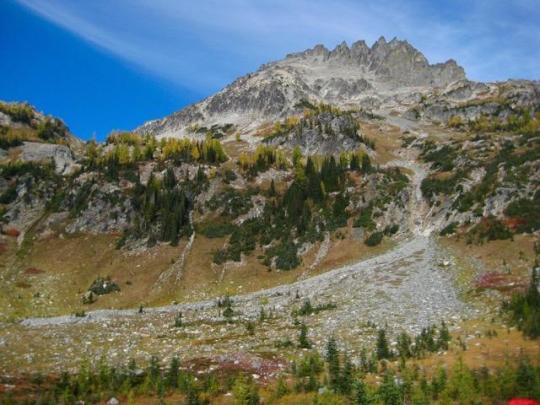
DAY 2: We awoke at 5:30am and were on the move with summit packs just after sunrise. Our plan was to climb the northwest ridge of Seven-Fingered Jack, so we headed north to the 7700-foot col separating Leroy Creek and Big Creek. Views of Buck Mountain and other peaks to the west were excellent in the clear October air.
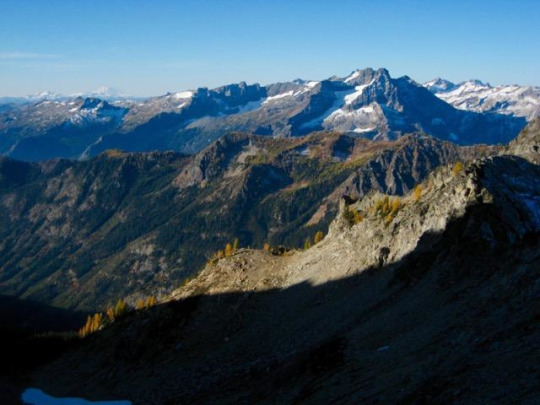
We soon reached the Big-Leroy Col (1.5 hours from camp), which marks the bottom of the northwest ridge. Steve and I had previously climbed this route in past decades but somehow managed to forget that it starts at a steep face of rotten volcanic breccia or tuff. Whatever the rock type, it was enough to make Lisa, Deb, Doug, Steve, and Eileen retreat back to the more-standard west slope route. Meanwhile, Fay and Brian and I decided to take our chances with the steep face. It began with an exposed Class 3 ledge system but soon eased off to Class 2-3 scrambling with only moderate exposure.

The upper part of the west ridge served up some very interesting Class 3 scrambling around numerous horns and pinnacles, but Brian decided to turn around near the midpoint. Eventually, Fay and I rejoined our west slope comrades and continued upward together.

We topped out in late morning (4.6 hours from camp) and enjoyed the calm summit for nearly an hour. Eileen had carried up Ed Miller’s memorial traveling register to leave for future parties.

Views included the incredible north face of Mt. Maude to the south...
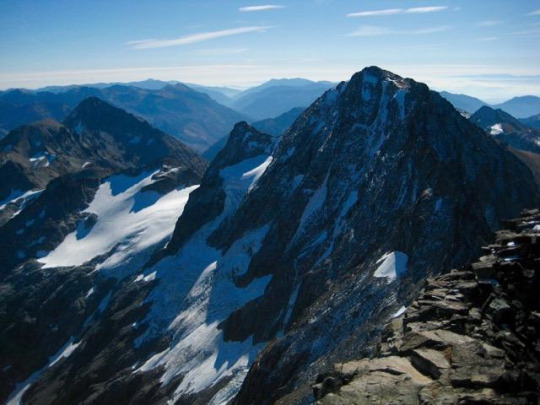
... Stuart Range farther to the south ...

... and Entiat Meadows directly below.

We headed back down to Leroy Basin by way of the expansive southwest slope.
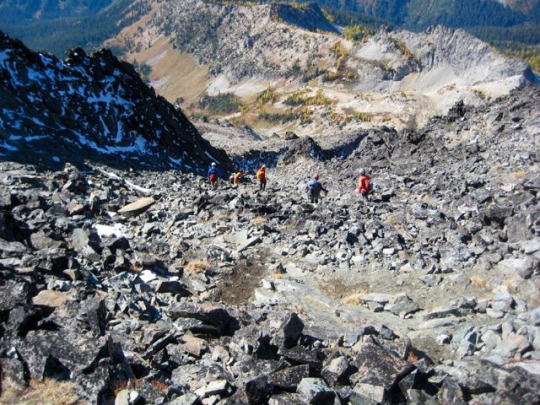
Once back at camp, we packed up and headed south on the Carne Mountain High Route, following the old sheepherder’s trail up to 6900-foot Leroy Pass.

The pass offered us one last look back at Seven-Fingered Jack and Leroy Basin before we turned east and left the trail.

Faint footpaths led up heather, talus, and scree to 7600-foot Ice Lakes Pass. Late-afternoon shadows were stretching across Upper Ice Lake just as we arrived at the pass. We hurried down to the lake and set up camp on some conveniently flat but very exposed pumice terraces (2.9 hours from Leroy Basin).

DAY 3: After a comfortable night of being lightly buffeted by mountain breezes, we awoke to a gorgeous sunrise over Spectacle Buttes. Or should I call them “Spectacular Buttes”?

Upper Ice Lake is strikingly beautiful in an austere, lunar-esque fashion. I think that if the moon had lakes and larch trees, it would look very similar to this.

Pink clouds streaked across the western sky ...
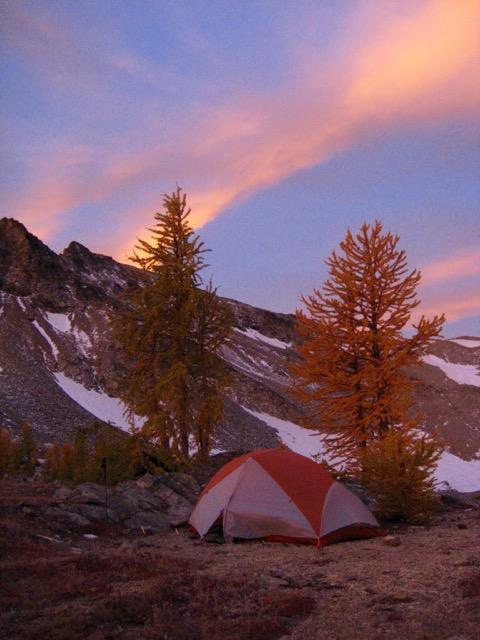
... and alpenglow lit up Mt. Maude.

During breakfast, Steve, Deb, and Brian announced that they would break camp and head out today, adding a climb of Mt. Maude along the way. Lisa, Doug, Fay, Eileen, and I, on the other hand, decided to make a day trip over to Spectacle Buttes. We began with a traverse around the shore of Upper Ice Lake.

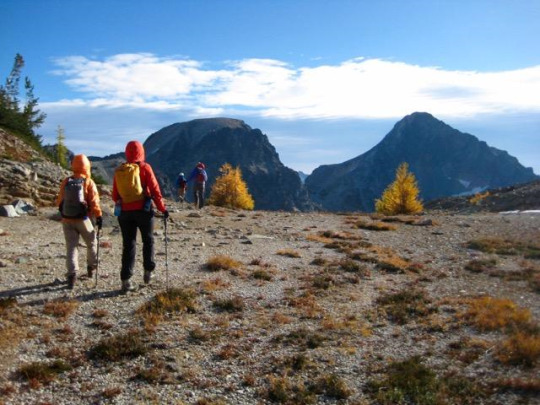

We then dropped down to Lower Ice Lake, which has a user-friendly shoreline and an inviting larch-studded island.

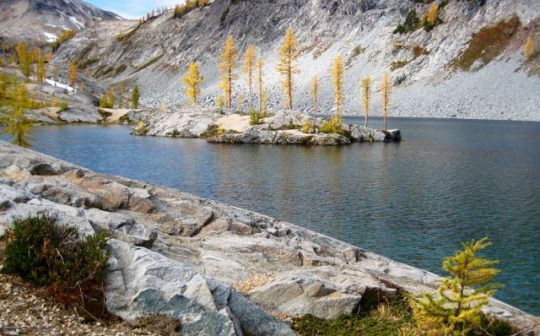
At the lower lake, Lisa and Doug veered off to climb North Spectacle Butte, whereas Fay, Eileen, and I proceeded in the direction of South Spectacle Butte. This involved a short descent into the Ice Creek valley, then a traverse below the north butte. We crossed over the top of a huge erosion gully along the way.
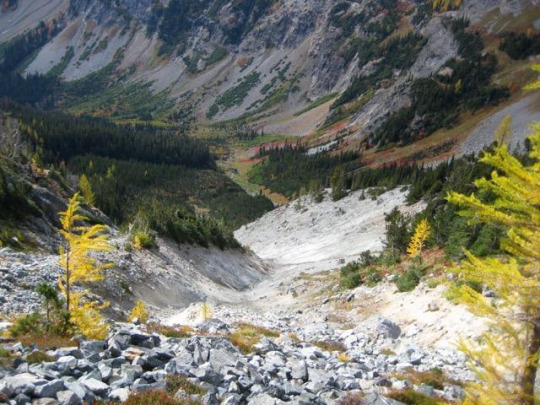
An ascent through a high larch basin ended at 7300-foot Spectacle Col, between the two buttes.

Beckey’s original Cascade Alpine Guide indicates that South Spectacle Butte can be readily climbed from this col, so we were game to give it a whirl. The first 600 feet was straightforward and enjoyable, but we soon encountered an impassable notch at 7900 feet. After several attempts to get beyond the notch, we reluctantly decided to retreat and traverse over to North Spectacle Butte.

We contoured around the eastern side of the north butte, then scrambled up the northeast ridge, arriving on the summit in late afternoon (7.0 hours from camp).

The skies had been growing dark and ominous throughout the afternoon, and a light snow started to fall just as we left the summit.
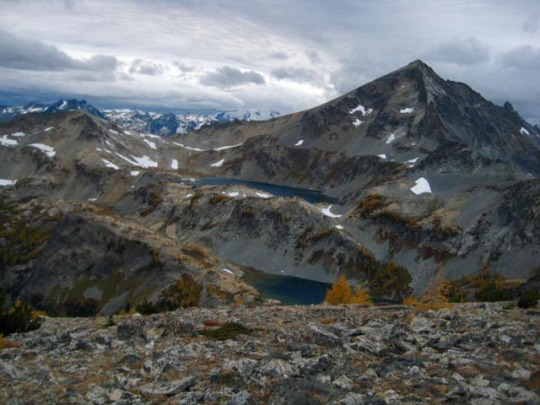
We raced down the peak’s west ridge, dropped into Lower Ice Lake, then hiked back up to our camp at Upper Ice Lake. Gusty winds spit graupel pellets in our faces as we made the final traverse to camp (1.7 hours from summit). Doug and Lisa had arrived an hour before us, having tucked in North Spectacle Butte earlier in the day.
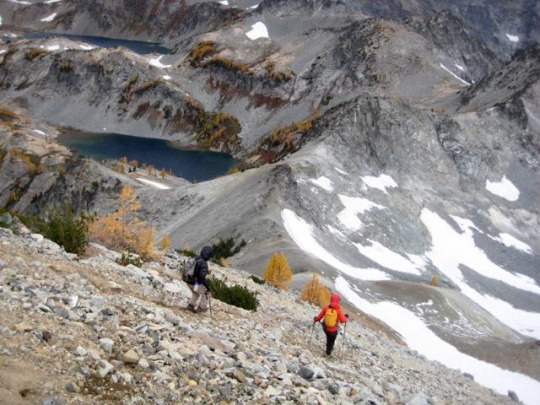
NIGHT 3: After eating a hasty dinner in the brewing storm, we all retreated to our respective tents around 7:00pm. The winds continued to grow in intensity throughout the evening, and the snowfall increased. Before long, it became a full-blown blizzard. Somewhere around 10:00pm, I got out to re-stake our wind-battered tent with rock anchors, and then I stumbled off to check on the others. Doug’s single-wall Megamid tent had suffered a blow-out at the apex and collapsed on top of him; he had no choice but to lie under it like a tarp. Fay’s lightweight double-wall tent was still standing, but it deformed badly under the wind loading and was filling with spindrift; she and Lisa were doing their best to hold it up from within.
I scurried back to our tent and jumped inside. For the next 2 hours, the winds became even more ferocious. To make things worse, the gusts continually changed direction; one gust would roar in from the west, circle around Ice Lake, then roar back in from the east. We later estimated that they reached speeds in the range of 60 to 80 mph at their peak. I spent most of that time with my feet pushed up against the corners of the tent ceiling, trying to keep it from folding over under the tremendous load. Eileen got out at midnight to replace anchor rocks that had been moved and stakes that had pulled out. Around 1:00am, the gusts abated slightly, and we both dozed off. This rest was short-lived, however, because we were awoken at 2:00am when our tent partially collapsed due to a broken pole. With no means to repair a tent pole during a blizzard, our only option was to huddle inside and accept the incoming spindrift. It was a long night.
DAY 4: At 5:20am, I announced to Eileen that it was time to move. I emptied the spindrift out of my boots and got dressed in my full battle armor, then crawled out the rally the others. Doug was more than happy to get out from under his flattened pyramid. Likewise, Fay and Lisa were very ready to escape their snow-filled cocoon. We all packed up in the still-howling wind, being careful to keep a grasp on each item lest it be whipped off to the Entiat Valley. As we ate breakfast behind a windbreak, the eastern sky gradually lightened and began to splash dawn colors across the frozen landscape. It was a visually stunning aftermath to a wild night.
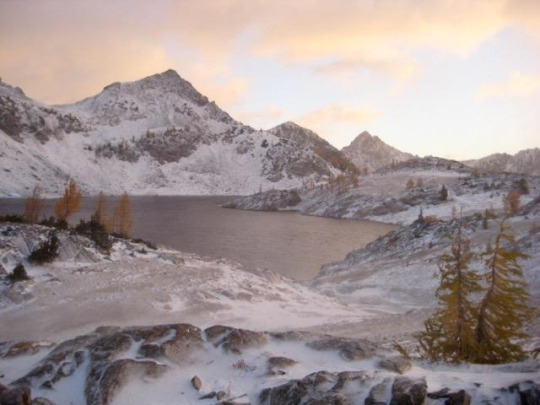


We trudged up to Ice Lakes Pass and took a short break to soak in one last view of Upper Ice Lake to the east.
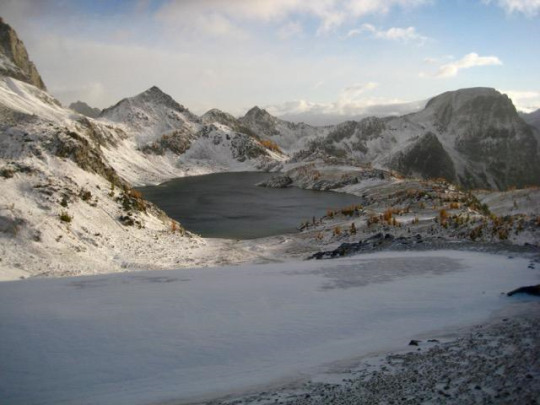
To the west, dark storm clouds battled with patches of deep-blue sky.

We spent the rest of our day hiking through a snowy wonderland along the Carne-Leroy High Route and down to the trailhead.
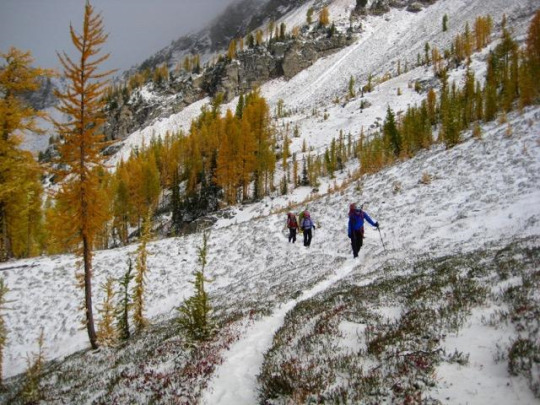
Around midday, we encountered Dave and Milda, who had also been camped at Upper Ice Lake the night before. We shared survivor tales with them, and laughed at the helplessness of our respective situations. For all of us, we felt that we’d lived through MOAB: the Mother Of All Blizzards! Fay later summed it up perfectly by saying, “We had a once in a lifetime experience; one not to missed but one not to ever be repeated.” Amen.
Approximate Total Stats: 28 miles traveled; 13,700 feet gained & lost; 3 tents damaged.
#ice lakes#seven-fingered jack#7fj#spectacle buttes#carne basin#Leroy basin#entiat mountains#Cascade Mountains#golden larch
0 notes